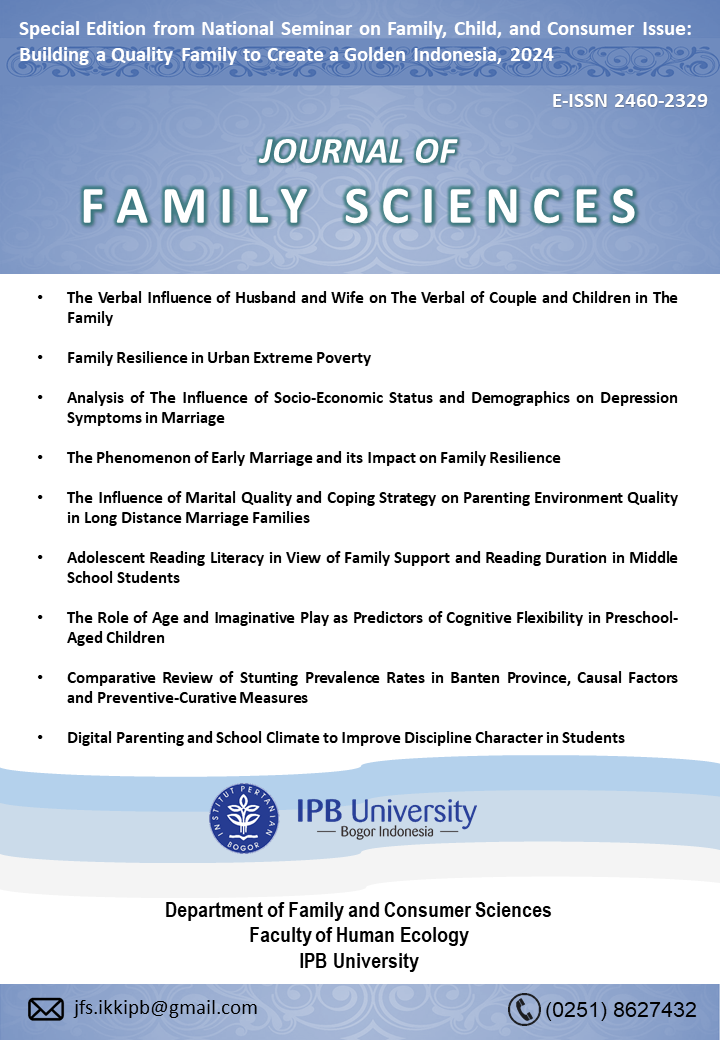The Role of Age and Imaginative Play as Predictors of Cognitive Flexibility in Preschool-Aged Children
Abstract
Cognitive flexibility is a part of executive function that helps individuals adjust to changing circumstances, which is important for children to adapt with surroundings. Alongside with rapid cognitive development during preschool-age, preschoolers also show maturity in symbolic functions that grow distinct characteristics in imaginative play. This research aimed to see the role of age and imaginative play in predicting preschool-aged children's cognitive flexibility. Sample was carried out using a convenience-sampling technique and this research subjects were 74 preschoolers (4–6 years) and their parents. Participants in this study are preschool-aged children who are enrolled at preschool in Jakarta, Bogor, and Depok areas, along with parents or guardians of the children who accompanied the children in their daily activities at home. This study used hierarchical linear regression analysis techniques in SPSS to analyze the role of age and imaginative play in predicting cognitive flexibility. The result showed both age and imaginative play significantly predict cognitive flexibility. Age has 9.4 percent of the role, whereas imaginative play accounted for 8.3 percent. These provide an illustration for parents and educators that imaginative play activities can facilitate the development of cognitive flexibility at preschool age.
Downloads
References
Anzani, R. W., & Insan, I. K. (2020). Perkembangan sosial emosi pada anak usia prasekolah. PANDAWA, 2(2), 180-193. Retrieved from https://ejournal.stitpn.ac.id/index.php/pandawa/article/view/595
Arán Filippetti, V., & Krumm, G. (2020). A hierarchical model of cognitive flexibility in children: Extending the relationship between flexibility, creativity and academic achievement. Child Neuropsychology, 26(6), 770-800. https://doi.org/10.1080/09297049.2019.1711034
Bauer, R. H., Gilpin, A. T., & Thibodeau-Nielsen, R. B. (2021). Executive functions and imaginative play: Exploring relations with prosocial behaviors using structural equation modeling. Trends in Neuroscience and Education, 25, 100165. https://doi.org/10.1016/j.tine.2021.100165
Blanchard de Assis, R. (2020). Religious identity and imagination in early childhood (Doctoral dissertation).
Buttelmann, F., & Karbach, J. (2017). Development and plasticity of cognitive flexibility in early and middle childhood. Frontiers in Psychology, 8, 1040. https://doi.org/10.3389/fpsyg.2017.01040
Carlson, S. M., White, R. E., & Davis-Unger, A. C. (2014). Evidence for a relation between executive function and pretense representation in preschool children. Cognitive Development, 29, 1-16. https://doi.org/10.1016/j.cogdev.2013.09.001
Deák, G. O., & Wiseheart, M. (2015). Cognitive flexibility in young children: General or task-specific capacity?. Journal of Experimental Child Psychology, 138, 31-53. https://doi.org/10.1016/j.jecp.2015.04.003
Diamond, A. (2013). Executive functions. Annual Review of Psychology, 64, 135-168. https://doi.org/10.1146/annurev-psych-113011-143750
Field, A. (2013). Discovering statistics using IBM SPSS statistics. Sage Publication.
Gleason, T. R., & White, R. E. (2023). Pretend Play as Abstraction: Implications for Early Development and Beyond. Neuroscience & Biobehavioral Reviews, 105090. https://doi.org/10.1016/j.neubiorev.2023.105090
Göncü, A., & Vadeboncoeur, J. A. (2017). Expanding the definitional criteria for imaginative play: Contributions of sociocultural perspectives. Learning & Behavior, 45, 422-431. https://doi.org/10.3758/s13420-017-0292-z
Gravetter, F. J., & Forzano, L. B. (2012). Research methods for the behavioral sciences. Stanford: Cengage Learning.
Hendrawan, D., Fauzani, F., Carolina, C., Fatimah, H. N., Wijaya, F. P., & Kurniawati, F. (2015, November). The construction of executive function instruments for early child ages in Indonesia: A pilot study. In Proceedings International Conference on Child and Adolescent Mental Health. Tangerang Selatan, Banten: Faculty of Psychology State Islamic University Syarif Hidayatullah Jakarta (pp. 17-28).
Howard, J., & McInnes, K. (2013). The essence of play: A practice companion for professionals working with children and young people. Routledge. https://doi.org/10.4324/9780203075104
Johnson, J. E., Christie, J. F., Yawkey, T. D. (1999). Play and early childhood development (2nd ed.). Longman.
Marotz, L. R., & Kupzyk, S. (2018). Parenting today's children: A developmental perspective. Cengage Learning.
Papalia, D. E., Martorell, G. (2021). Experience human development (14th ed.). McGraw Hill.
Podjarny, G., Kamawar, D., & Andrews, K. (2022). Two birds in the hand: Concurrent and switching cognitive flexibility in preschoolers. Journal of Experimental Child Psychology, 220, 105418. https://doi.org/10.1016/j.jecp.2022.105418
Quiñones-Camacho, L. E., Fishburn, F. A., Camacho, M. C., Wakschlag, L. S., & Perlman, S. B. (2019). Cognitive flexibility-related prefrontal activation in preschoolers: A biological approach to temperamental effortful control. Developmental Cognitive Neuroscience, 38, 100651.
Quiñones-Camacho, L. E., Fishburn, F. A., Camacho, M. C., Wakschlag, L. S., & Perlman, S. B. (2019). Cognitive flexibility-related prefrontal activation in preschoolers: A biological approach to temperamental effortful control. Developmental Cognitive Neuroscience, 38, 100651. https://doi.org/10.1016/j.dcn.2019.100651
Rahman, A. A., Tan, H. K., Loo, S. T., Malik, A. B. A., Tan, K. H., Gluckman, P. D., ... & Rifkin-Graboi, A. (2022). Cognitive flexibility in preschoolers: A role for the late frontal negativity (LFN). Cognitive Development, 63, 101200. https://doi.org/10.1016/j.cogdev.2022.101200
Sheridan, M. D. (2011). Play in early childhood: From birth to six years old (3rd ed.). Routledge.
Šimleša, S., & Cepanec, M. (2015). Development of executive functions during childhood. International Encyclopedia of the Social & Behavioral Sciences, 489-496. https://doi.org/10.1016/B978-0-08-097086-8.23083-3
Thibodeau‐Nielsen, R. B., & Gilpin, A. T. (2020). The role of emotion regulation in the relationship between pretense and executive function in early childhood: For whom is the relationship strongest?. Infant and Child Development, 29(5), e2193. https://doi.org/10.1002/icd.2193
Thibodeau-Nielsen, R. B., Gilpin, A. T., Nancarrow, A. F., Pierucci, J. M., & Brown, M. M. (2020). Fantastical pretense's effects on executive function in a diverse sample of preschoolers. Journal of Applied Developmental Psychology, 68, 101137. https://doi.org/10.1016/j.appdev.2020.101137
Thompson, B. (2020). Pretend play across the preschool years: Defining and observing its developmental progression (Doctoral dissertation, George Mason University).
Thompson, B. N., & Goldstein, T. R. (2019). Disentangling pretend play measurement: Defining the essential elements and developmental progression of pretense. Developmental Review, 52, 24-41. https://doi.org/10.1016/j.dr.2019.100867
Vasantha, W. B., Kandasamy, I., Smarandache, F., Devvrat, V., & Ghildiyal, S. (2020). Study of imaginative play in children using single-valued refined neutrosophic sets. Symmetry, 12(3), 402. https://doi.org/10.3390/sym12030402
Veraksa, N., Gavrilova, M., & Veraksa, A. (2022). “Complete the drawing!”: The relationship between imagination and executive functions in children. Education Sciences, 12(2), 103. https://doi.org/10.3390/educsci12020103
Vitiello, V. E., Greenfield, D. B., Munis, P., & George, J. L. (2011). Cognitive flexibility, approaches to learning, and academic school readiness in Head Start preschool children. Early Education & Development, 22(3), 388-410. https://doi.org/10.1080/10409289.2011.538366
Walker, S., Fleer, M., Veresov, N., & Duhn, I. (2020). Enhancing executive function through imaginary play: A promising new practice principle. Australasian Journal of Early Childhood, 45(2), 114-126. https://doi.org/10.1177/1836939120918502
White, R. E., & Carlson, S. M. (2021). Pretending with realistic and fantastical stories facilitates executive function in 3-year-old children. Journal of Experimental Child Psychology, 207, 105090. https://doi.org/10.1016/j.jecp.2021.105090
Yeniad, N., Malda, M., Mesman, J., van IJzendoorn, M. H., Emmen, R. A., & Prevoo, M. J. (2014). Cognitive flexibility children across the transition to school: A longitudinal study. Cognitive Development, 31, 35-47. https://doi.org/10.1016/j.cogdev.2014.02.004
Zelazo, P. D. (2006). The dimensional change card sort (DCCS): A method of assessing executive function in children. Nature protocols, 1(1), 297-301. https://doi.org/10.1038/nprot.2006.46
Copyright (c) 2024 Journal of Family Sciences

This work is licensed under a Creative Commons Attribution 4.0 International License.
Authors who publish with this journal agree to the following terms:
- Authors retain copyright and grant the journal right of first publication with the work simultaneously licensed under

This work is licensed under a Creative Commons Attribution 4.0 International License. that allows others to share the work with an acknowledgement of the work's authorship and initial publication in this journal. - Authors are able to enter into separate, additional contractual arrangements for the non-exclusive distribution of the journal's published version of the work (e.g., post it to an institutional repository or publish it in a book), with an acknowledgement of its initial publication in this journal.
- Authors are permitted and encouraged to post their work online (e.g., in institutional repositories or on their website) prior to and during the submission process, as it can lead to productive exchanges, as well as earlier and greater citation of published work (See The Effect of Open Access).



_001.png)



